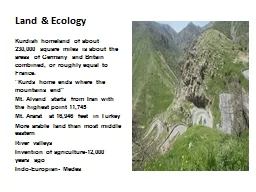

France Kurds home ends where the mountains end Mt Alvand starts from Iran with the highest point 11745 Mt A rarat at 16946 feet in Turkey More arable land than most middle eastern ID: 806371
Download The PPT/PDF document "Land & Ecology Kurdish homeland of a..." is the property of its rightful owner. Permission is granted to download and print the materials on this web site for personal, non-commercial use only, and to display it on your personal computer provided you do not modify the materials and that you retain all copyright notices contained in the materials. By downloading content from our website, you accept the terms of this agreement.
Slide1
Land & Ecology
Kurdish homeland of about 230,000 square miles is about the areas of Germany and Britain combined, or roughly equal to
France.
“Kurds
home ends where the mountains
end”
Mt.
Alvand
starts from Iran with the highest point 11,745
Mt.
A
rarat at 16,946 feet in Turkey
More arable land than most middle eastern
River valleys
Invention of agriculture-12,000 years ago
Indo-
Europian
- Medes
Slide2Population
Northern Kurdistan-Southeast Turkey
15 to 20 million
Eastern Kurdistan-Northwest Iran
6-7 million
Southern Kurdistan-Northern Iraq
5-6 million
West or
Rojava
-Northern Syria
3.5-4 million
Slide3History
Being the native inhabitants of their land there are no "beginnings" for Kurdish history and people. Kurds and their history are the end products of thousands of years of continuous internal evolution and assimilation of new peoples and ideas introduced sporadically into their land
.
Genetically, Kurds are the descendants of all who ever came to settle in Kurdistan, and not any one of them
.
By about 2,600 years ago, the Medes had already set up an empire that included all Kurdistan and vast territories far beyond.
The Treaty of Sevres (signed August 10, 1921) anticipated an independent Kurdish state to cover large portions of the former Ottoman Kurdistan. Unimpressed by the Kurds' many bloody uprisings for independence, France and Britain divided up Ottoman Kurdistan between Turkey, Syria and Iraq. The Treaty of Lausanne (signed June 24, 1923) formalized this division. Kurds
in Iran
,
were
kept where they were by Teheran
.
Slide4Geopolitics
Since the end of World War I, Kurdistan has been administered by five sovereign states, with the largest portions of the land being respectively in Turkey (43%) , Iran (31%), Iraq (18%), Syria (6%) and the former Soviet Union (2%).
The Kurds part of Iran
have lived under that state's jurisdiction since
1514
The
other three quarters of the Kurds lived in the Ottoman Empire from that date until its break-up following WWI. The French Mandate Syria received a piece, and the British incorporated central Kurdistan or the
into Mandate
of Iraq.
Northern
and western Kurdistan were to be given choice of independence by the Treaty of Sevres(August 10, 1920
)
but instead they were awarded to the newly established Republic of Turkey under the term of the Treaty of Lausanne (June 24, 1923).
The
Russian/Soviet Kurds had passed into their sphere in the course of the 19th century when territories were ceded by Persia/Iran.
Slide5Language
Modern kurdish
Kurmanji
group
¾ or 15-20 million
Sorani
- 6-7 million
Gurani-Zaza
dialects
10-12 million
Slide6Religion
Muslims-Sunni
Muslims-
Shiete
3/5
th
1/2 million
Alawies
(Turkey)-distinct
from
islam20 %Yazidies -Islam-judaism-christianity 2 %Yarasan-Ahle Haq13 %Bahaie and Christian1 %
Sufiesm (Islamic Mystic)Chant and dance to worship Allah
Slide7Culture & Life
Family oriented
Marriage between cousins is common
Tribal leadership is inherited
Kurdish women freely associate with men
Rich in culture
Oral tradition:
E
pic poems: adventure of love and battle
Literature appeared in 7
th
centuryDance and music
Slide8Dance
Slide9Music
Slide10Celebrations and major holidays
New Year-March 21
st
Folktale-
Kawe
the
Blacksmith
Islamic Holidays
Ramazan
The birth of Profit
Mohammad
Slide11Newroz-New Year
Slide12Slide13Wedding-Rojava
Slide14Northern – South East Turkey
Slide15Rojava
Women Fashion Show
Newroz
Festival
Slide16Southern – Northern Iraq
Slide17Eastern Kurdistan
Slide18Rojava-Popular Meals
Slide19Kelane
Dolme
Slide20Village Life
Slide21Life in villiage
Slide22Village in Eastern Kurdistan
Slide23Peshmarge & Freedom Fighters
Slide24Global rally for peace and freedom in Kubane
Slide25A way of life for the Kurds
Slide26What will be the future for them?
Slide27Thank You